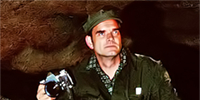Back to Don's Maps
Bédeilhac Cave - Grotte de Bédeilhac
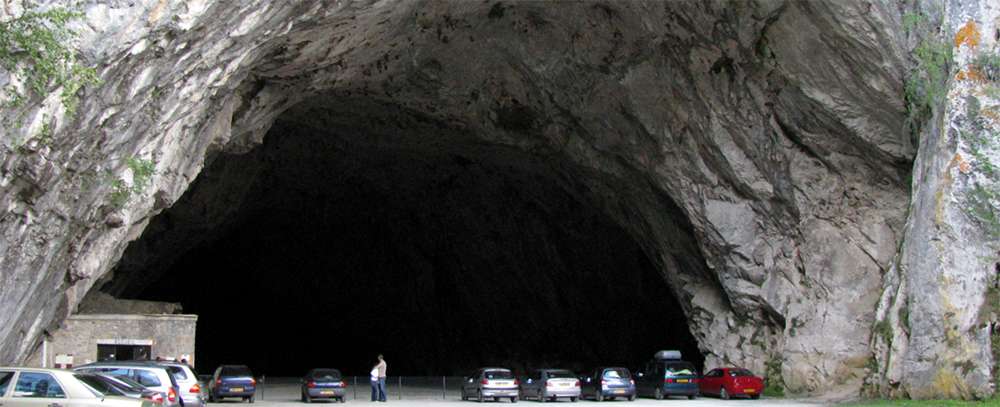
Photo: Don Hitchcock 2008
The cave of Bédeilhac has an enormous entrance – 17 metres at its highest point. Unfortunately the size of the cave’s mouth meant that it was an ideal natural hangar for aircraft. The French military occupied the cave from 1938, and they were followed by the German military during their occupation of France during World War II. The Germans army levelled the cave floor and laid a concrete base on which aircraft were stored and buildings constructed. In the process they destroyed much of the archaeological deposits of the first 350 metres of the cave. The military activities with heavy machinery and engines also did not do much for the painted and engraved imagery in some of the side galleries.Text above: https://archaeology-travel.com/france/bedeilhac/
This destructive activity aside, Bédeilhac still has a great diversity of parietal and portal art. There are some truly exquisite examples of carved bone artefacts. The parietal art includes both paintings and engravings – paintings in black and red – and even the use of wet clay as a pigment. The clay on the floor of the cave hardened to form small portable ‘plaquettes’ on which artists engraved individual images of animals. Some of the side galleries are closed to the public, but the main gallery is accessible by with guided tour, during which visitors get to see a number of interesting examples of Palaeolithic art in the cave.
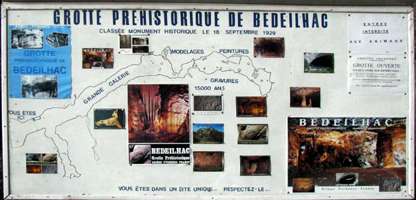
Sign outside the cave, including a floor plan of the cave.
Photo: Don Hitchcock 2008
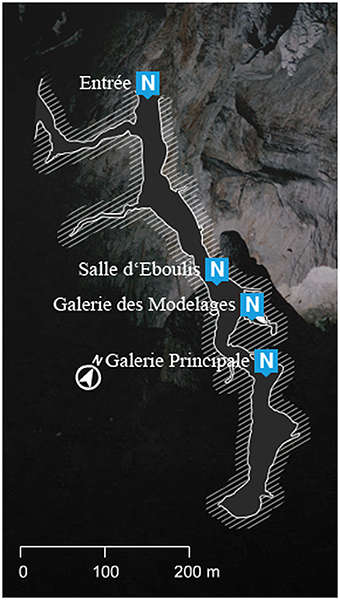
Plan of the cave.
Photo: Heinrich Wendel (© The Wendel Collection, Neanderthal Museum)
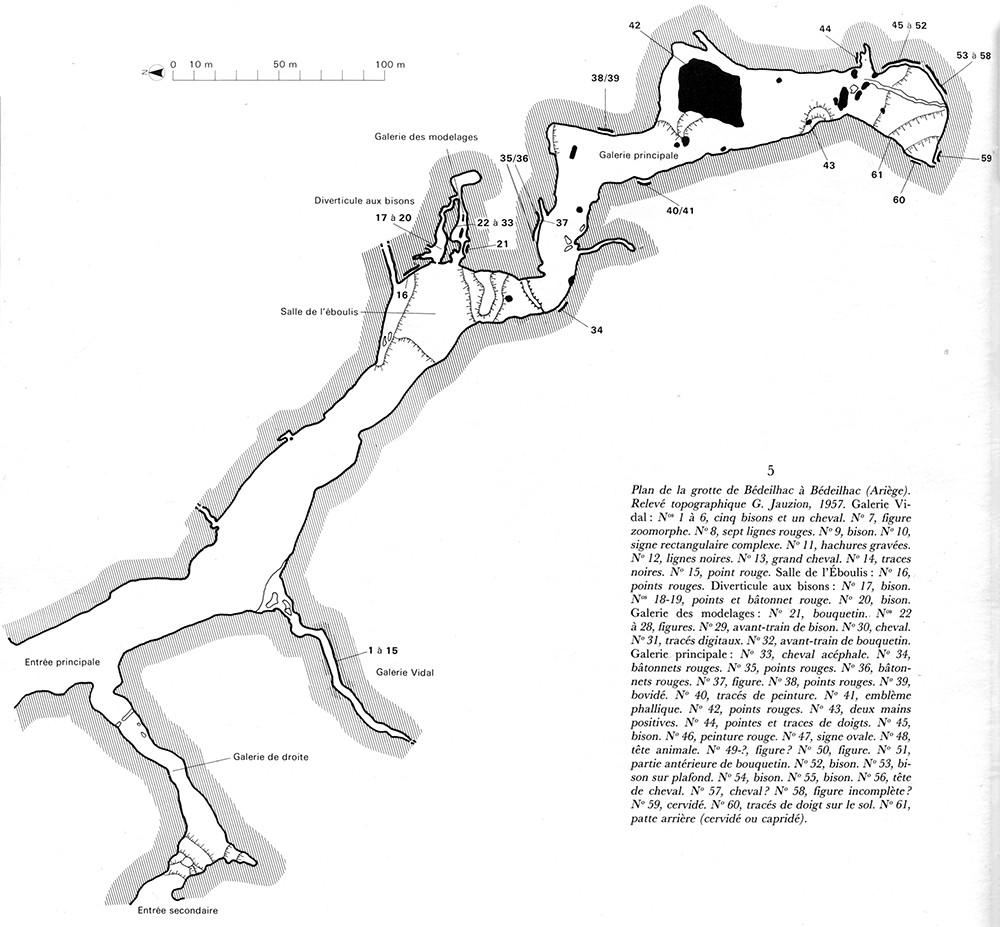
Plan of the cave.
Photo and text: G. Jauzion, 1957, in Leroi-Gourhan (1984)
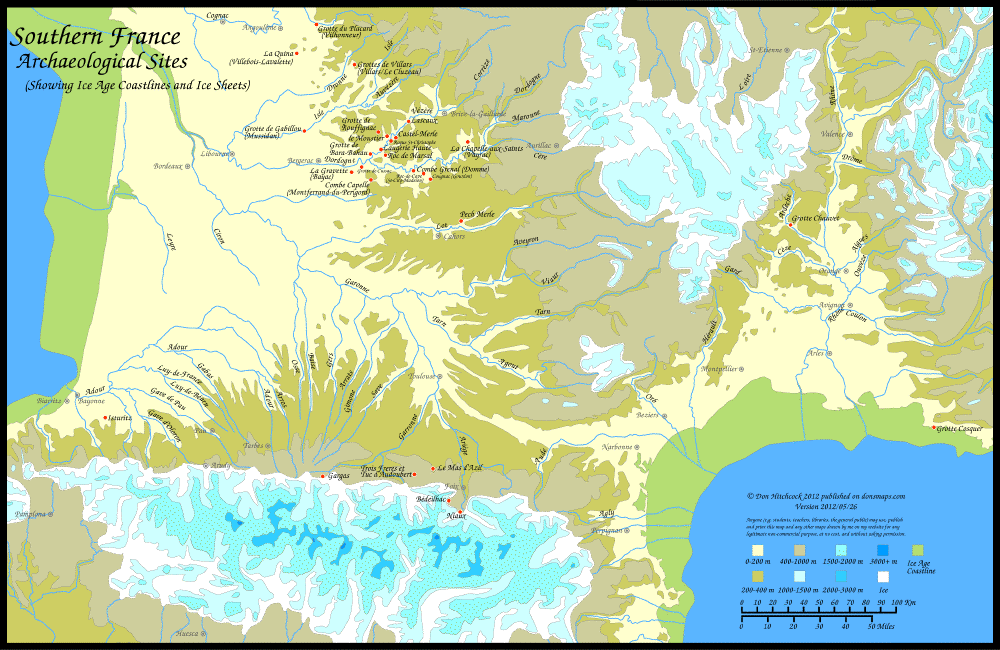
Note - Use the pdf file, version 2012/05/26 if you wish to print this on a single sheet of paper.
Photo: Don Hitchcock version 2012/05/26
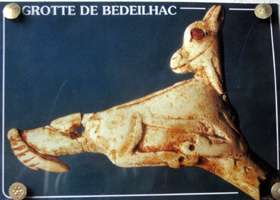
This postcard pinned to the noticeboard implies correctly that yet another of those propulseurs with a bird (or birds) sitting on a turd emerging from a fawn was found here. They were mass produced in the Magdalenian in this general area, and there are many examples. The design was refined as time went by to this shape, which was less likely to break because of various small but significant changes to the sculpture. The head was turned backwards to make it less breakable, and the legs were brought together for the same reason.
Obviously the people of the time thought it was a great design - toilet jokes never seem to go out of fashion!
Photo: Don Hitchcock 2008
Bandi (1988) says of this sculpture:
Propulseur of Bédeilhac - This is a fragment of reindeer antler depicting a chamois found by Romain Robert 30 km from Mas d'Azil, at Bedeilhac (Ariege), ten years after that of Mas d'Azil which it resembles in many details. The fragment is 9 cm. The head bears two large eyeballs which, as reported by Robert Roman "are represented by a mass of resinous appearance, surface slightly convex. We see, also leaving the rump of the animal, a kind of oblong mass or "sausage".
A small figurine which can be interpreted as a bird whose tail serves as a hook for the propulseur is attached to the rear of the animal. The chamois seems to be a young animal. Above the tail, there is a more or less rhombic hole which passes through the sculpture.
The Bédeilhac chamois squats, its legs are all folded under the abdomen, hooves touching. But the hooves each have a concavity, which had been originally filled with a blackish resinous substance, just like the eye sockets.
A trace of this material remains at the bottom of the concavities.
The belly of this animal also has lines etched to suggest a difference in color of the coat to the lower abdomen. The dewlap is well developed. The mouth and nose with nostrils and ears, are executed with great fidelity to the anatomy. Horns are absent, however, probably for reasons of fragility. It may be that the two propulseurs at Mas d'Azil and at Bédeilhac were completed by the same artist.
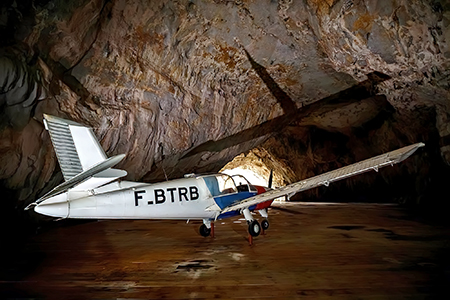
In the 1970s a TV movie about the French resistance was filmed here, and a plane was flown into and out of the cave.
( It would seem that the plane has now been put on permanent display in the cave - Don )
Photo: https://www.ariegepyrenees.com/en/cultural-heritage/bedeilhac-cave/
Text: http://www.prehistorictourist.com/bedeilhac
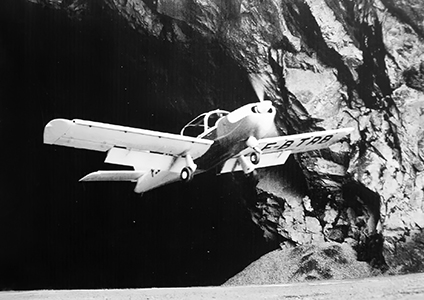
The plane used had amazingly short takeoff specifications.
Flaps down, gun the throttle, pull back on the stick and away we go...!
Photo: https://www.grandsudinsolite.fr/132--a-plane-in-the-cave-of-bedeilhac.html
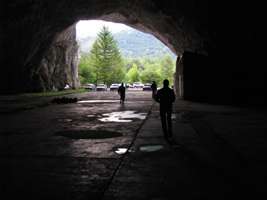
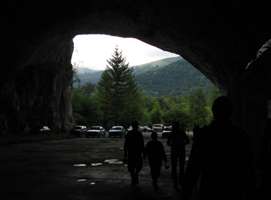
Although photos were not allowed inside, I was permitted to get these shots from outside the locked gate, looking towards the arch of the entrance to the cave.
Photo: Don Hitchcock 2008
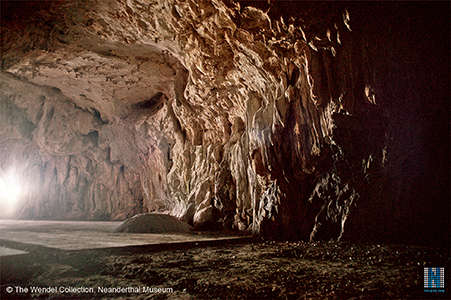
Another shot of the entrance.
Photo: Heinrich Wendel (© The Wendel Collection, Neanderthal Museum)
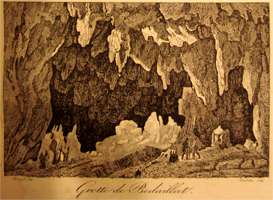
Early postcard from the 1830s of the Grotte de Bédeilhac, called Bedaillat on this postcard.
Photo: ebay
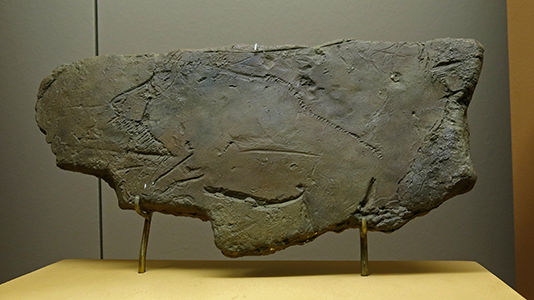
14: plaque de limon gravée figurant un bison.
14: Plaque of clay engraved with the figure of a bison.
Photo: Don Hitchcock 2014
Source: Facsimile, Musée d'Archeologie Nationale et Domaine, St-Germain-en-Laye
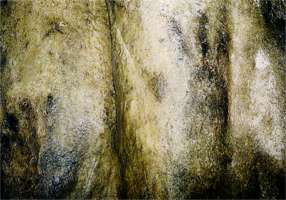
Hands shown as positive images - presumably by covering the hand with manganese dioxide, and pressing the hand to the rock face. The more normal images are negatives, obtained by spattering paint onto the hand and wall, resulting in a negative image.
Photo: N. Pailhaugue, in
Gailli (2006)
Galerie des Modelages
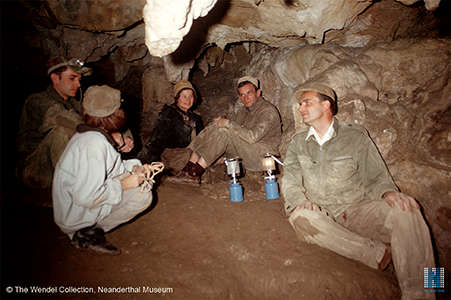
Heinrich Wendel (right) and his photographic team in Bedeilhac.
He needed assistants to help with carrying bulky photographic gear and aid with positioning and aiming lighting for his photographs.
Photo: Heinrich Wendel (© The Wendel Collection, Neanderthal Museum)
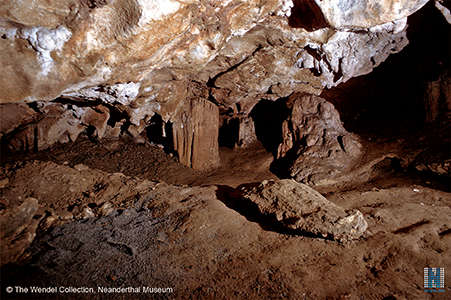
Entrance to the Gallery.
Photo: Heinrich Wendel (© The Wendel Collection, Neanderthal Museum)
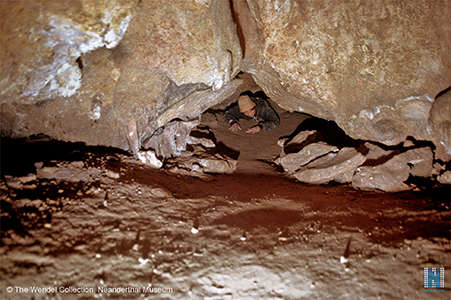
Some of the passages were difficult to squeeze through.
Photo: Heinrich Wendel (© The Wendel Collection, Neanderthal Museum)
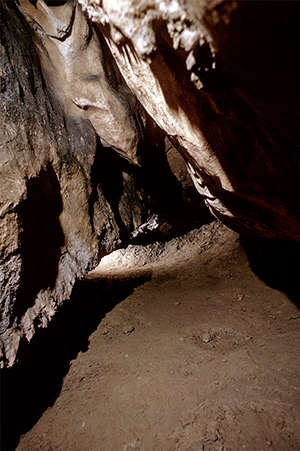
Black ochre (Manganese Dioxide) on a light coloured pendant of rock.
Photo: Heinrich Wendel (© The Wendel Collection, Neanderthal Museum)
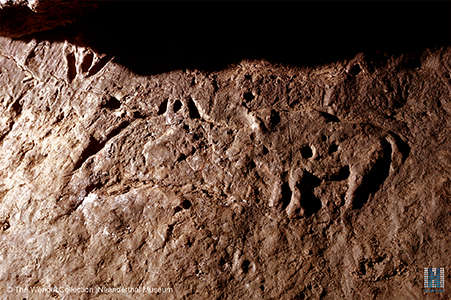
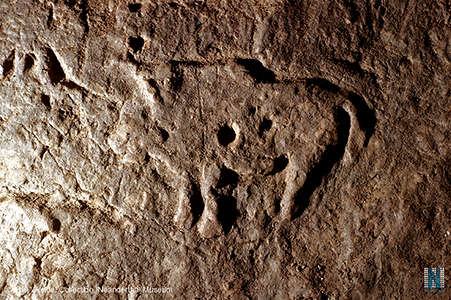
Bison in bas relief, head of an animal engraved to the left. The bison was created from a sheet of clay, then later attached to this position, presumably with clay slurry, as modern potters do, when faced with this task.
Photo: Heinrich Wendel (© The Wendel Collection, Neanderthal Museum)
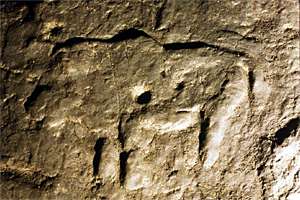
This bison is part of a series of well known clay models and engravings. By its nature and its location on a sloping clay slope, this artefact is very vulnerable and has suffered from accidental damage (some very old ones are already visible on photographs dating from the discovery), from touching and various deplorable smoothing actions which affect the readability and disallow virtually all technical observation.
The bison in full profile is the central figure of the group of sculptures of which it is a part. It seems that the animal was first formed on a sheet of clay 2 to 3 cm thick by way of cutting out the outline, and that this "preform" was then secured to the clay bench, and then its periphery was reshaped. This work is still visible on the upper part, from the head to the base of the tail, because it shows evidence of a deep groove which has traces of an old tool.
Photo: http://paleobox.forumactif.com/ou-voir-des-originaux-f12/musee-d-aurignac-et-sites-dans-les-pyrenees-et-ariege-t836.htm
Text: Translated and adapted from: http://w3.utah.univ-tlse2.fr/bedeilhac/AP/JM.7.html
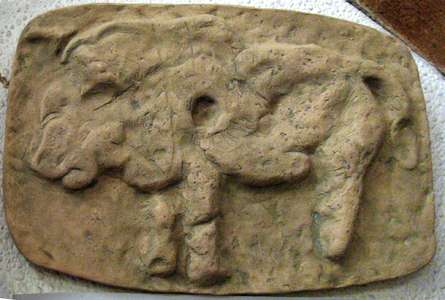
Bison in clay, Bedeilhac.
Photo: Don Hitchcock 2008
Source: Facsimile, Display, Musée Pyrénéen de Niaux
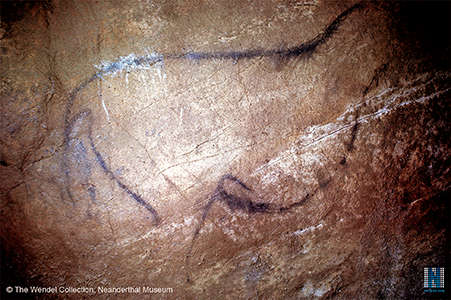
Outline of a pregnant mare. Other sources give its location as Galerie Mandement, which leads off the Galerie Principale, see the plan below.
Photo: Heinrich Wendel (© The Wendel Collection, Neanderthal Museum)
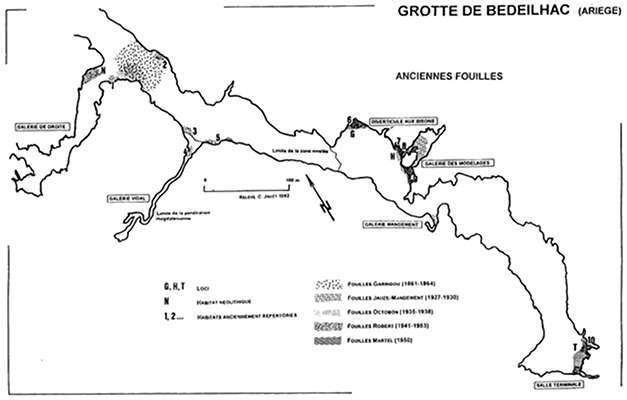
Plan of the cave.
Photo: http://traces.univ-tlse2.fr/
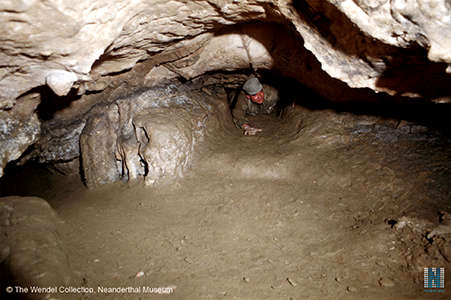
Heinrich Wendel squeezing under a low overhang.
Photo: Heinrich Wendel (© The Wendel Collection, Neanderthal Museum)
Galerie Principale
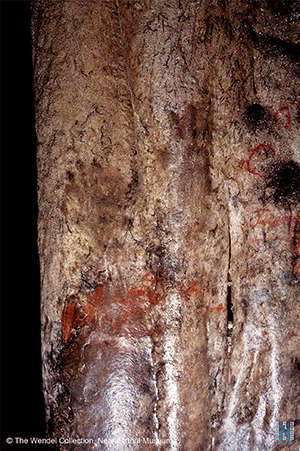
Two positive dark handprints, with what appears to be modern red graffiti.
Photo: Heinrich Wendel (© The Wendel Collection, Neanderthal Museum)
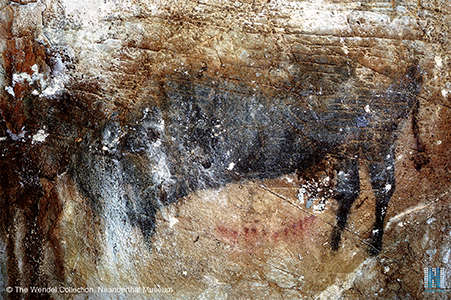
A Bison or Aurochs in dark pigment, with an arc of red ochre finger tip prints below it.
Photo: Heinrich Wendel (© The Wendel Collection, Neanderthal Museum)
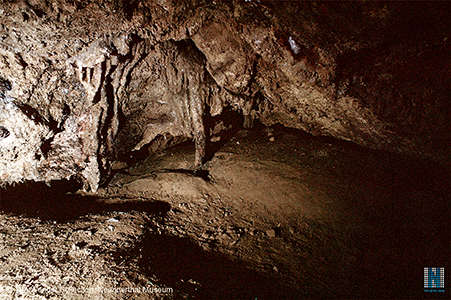
Shallow niche with a limestone pillar.
Photo: Heinrich Wendel (© The Wendel Collection, Neanderthal Museum)
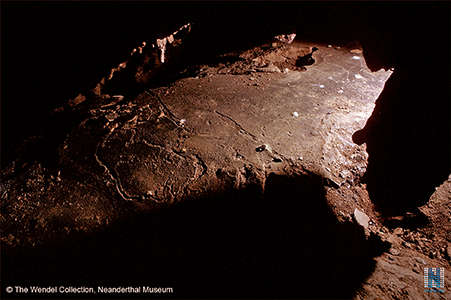
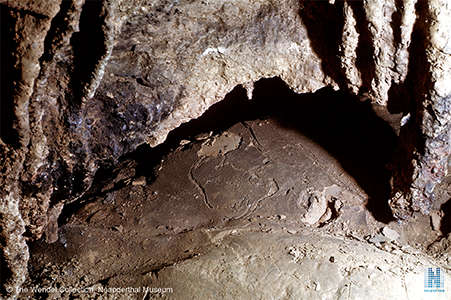
(left)
Very flat surface, but with no decipherable engravings from this viewpoint.
(right)
From this angle, however, we can make out the head and tusks of a mammoth, with a dorsal and ventral line, but no legs indicated.
Photo: Heinrich Wendel (© The Wendel Collection, Neanderthal Museum)
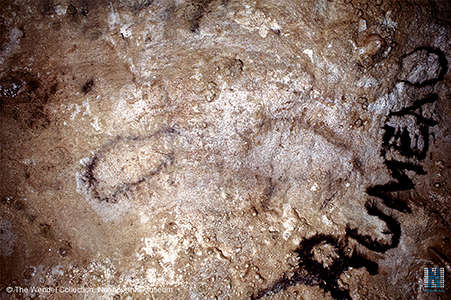
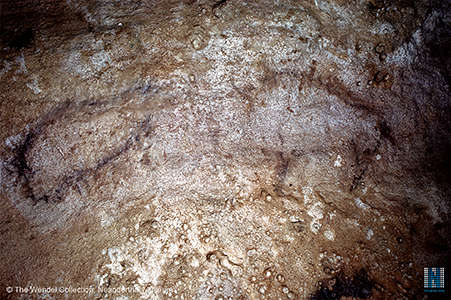
Two small bison outlined in black.
Photo: Heinrich Wendel (© The Wendel Collection, Neanderthal Museum)
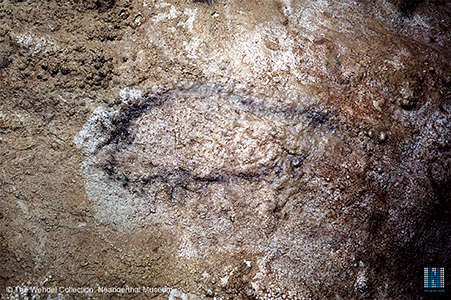
Close up of the left hand bison.
Photo: Heinrich Wendel (© The Wendel Collection, Neanderthal Museum)
Salle de l'Eboulis
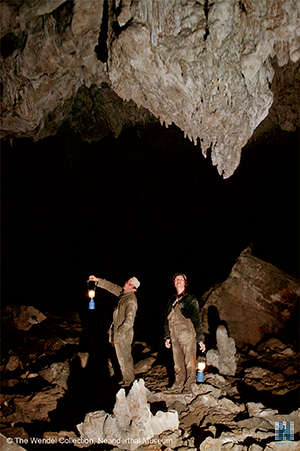
Inside the Salle de l'Eboulis, the Chamber of fallen rocks.
Photo: Heinrich Wendel (© The Wendel Collection, Neanderthal Museum)
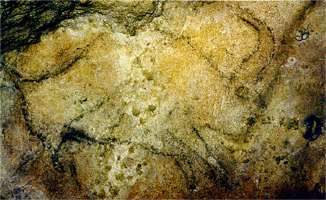
Bison drawn in black on the ceiling of the salle terminale, in receding perspective.
Photo: N. Pailhaugue, in
Gailli (2006)
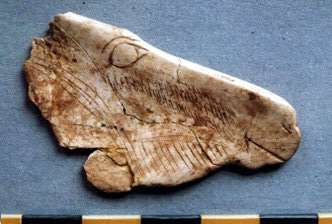
Horse head, length 48 mm.
Excavated by R. Robert in the Salle Terminale, foyer T.
Reference: Malvesin Fabre, Nougier et Robert (1953) ; Buisson et al. (1996)
Photo: http://w3.utah.univ-tlse2.fr/bedeilhac/ArtMobilier/IndexMAN.html
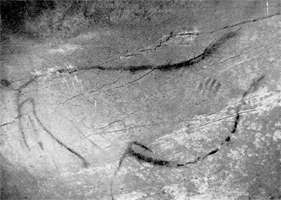
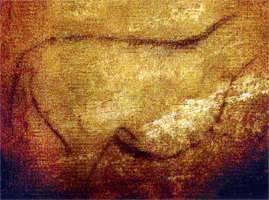
Large drawing of a horse in black in the Galerie Mandement. It is known as "the pregnant mare".
Photo (left): after Robert (1946), in Beltrán et al. (1967)
Photo (right): N. Pailhaugue, in
Gailli (2006)

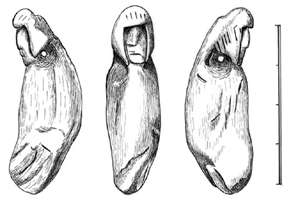
The Bedeilhac Venus - a horse canine tooth pierced and sculpted. 47 mm long, Discovered in the Jauze-Mandement section, the third terrace. It was part of a necklace of perforated teeth.
The sculpture represents a human head with eyes, a very large nose, and it seems to be amazed, the mouth partially open. The figure is framed by a sort of hood. There is a biconical transverse perforation through the neck.
It is known as "la Femme à la Capuche", and was discovered by Joseph Mandement, who also made the first crossing of the Green Lake at Niaux. He was an amateur archeologist, and made many discoveries at Niaux, Mas d'Azil and Bédeilhac.
Photo and text: w3.utah.univ-tlse2.fr/bedeilhac/ArtMobilier/MAN/75626.html
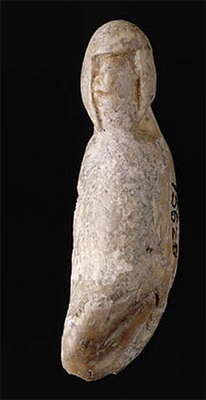
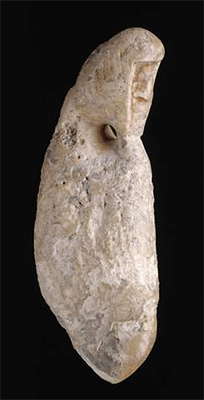
Another version of the sculpture above.
Photo: picasaweb.google.com/byThemis/idolies
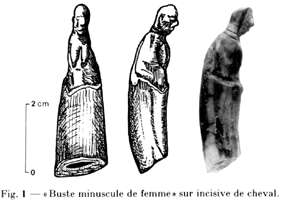
Note the similarity of the piece above to this one. It was discovered at Mas d'Azil by Édouard Piette, this little figurine was first described by him in 1888.
Piette (1888)
The figurine is 51 mm long, and has been sculpted in the root of a horse incisor. The shape was dictated to a large extent by the material used.
Photo: Duhard (1992)
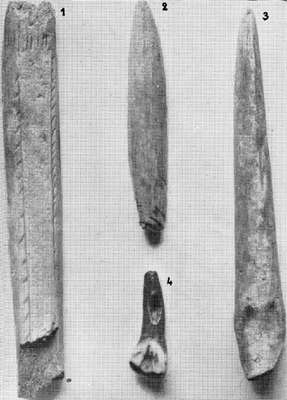
From Robert (1943) we get this (translated) description of the discovery of the objects pictured at left:
The improvements for industry made to the area in question, and the leveling of the floor of the cave, have left only narrow strips against the wall where archaeological layers remain.
Together with the remains of a fireplace located about 100 meters from the entrance, on the right of the main gallery, we found, in an area 150 cm long and 6 cm wide, completely encased in calcite:
3 cores, a chisel, a discoid scraper; a scraper point, a scraper-burin, two retouched truncated blades, 4 retouched flakes, and a superb burin of 8 cm long in sandstone.
The bone material includes a fragment of a smoother, and, shown in the photograph:
1 - a fragment, 10 cm long, of a baguette demi-ronde decorated with two side bands of lines and eight parallel lines at one end.
2 - the point of a spear
3 - a triangular sectioned point whose base has been broken
4 - a drilled bovine tooth
Photo: after Robert (1943), in Beltrán et al. (1967)

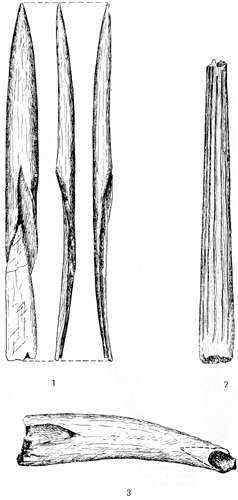
Bone industry of la grotte de Bédeilhac:
Left:
Polisher - used for finishing leather
Photo: Robert (1946)
Right:
1 Baguette demi-ronde in the process of being made
2 Decorated spear point
3 Tool handle
Photo and translated text: after Robert (1946), in Beltrán et al. (1967)
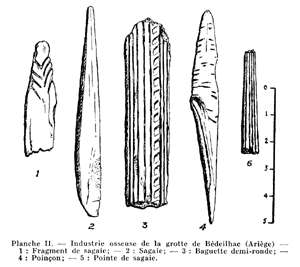
Bone industry of la grotte de Bédeilhac:
1 Fragment of a spear point
2 Spear point
3 Baguette demi-ronde
4 Point or awl
5 Spear point
Photo and translated text: Robert (1946)
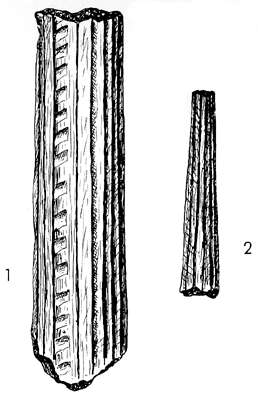
Bone industry of la grotte de Bédeilhac:
1 Fragment of a baguette demi-ronde (apparently the same artefact as 3 above)
2 Spear point (possibly the same as artefact 5 above)
Photo and translated text: after Robert (1946), in Beltrán et al. (1967)
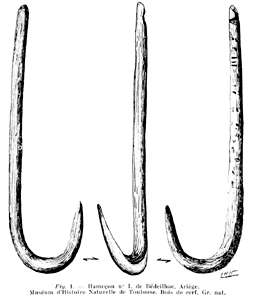
Fish hook from Bédeilhac, made of deer antler, from the Pyrenean Neolithic period.
At the end of the 1800s, Garrigou and Filhol, amongst some exceptional pieces recovered in the Grotte de Bédeilhac, found a large "spike", a beautiful hook in deer antler, without a barb.
It was described as a big spike, similar to a butcher's hook, carved in one piece. The large shank is 125 mm long, the short is 35mm in length, and the space between the two is 30mm, the thickness of the lower part of the hook is 10 mm. The curved part and the short branch are perfectly curved and polished.
The original is in the Muséum d'Histoire Naturelle de Toulouse
Photo and translated text: Nougier et Robert (1951)
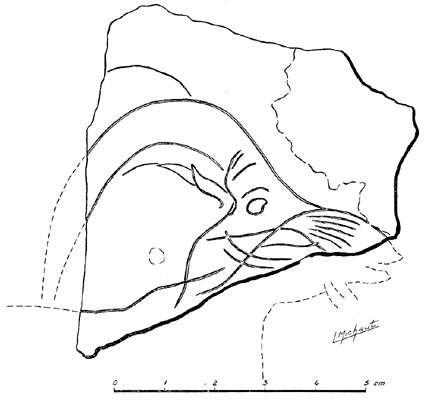
Sandstone plaquette fragment discovered by M. Vidal at the entrance to the gallery. On the one hand, it is possibly a goat's head, on the other there are traces of a possible head of bovid.
Photo and translated text: after Breuil et al. (1925), in Beltrán et al. (1967)
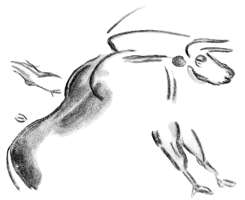
Large bison 200 cm metres long by 130 cm tall at the withers, black, turned to the right.
This is a clearly distinguished outline of a huge bison, with many traces of black lines that make use of natural projections of the rock to enhance the effect of the artwork.
Photo and translated text: after Breuil et al. (1925), in Beltrán et al. (1967)
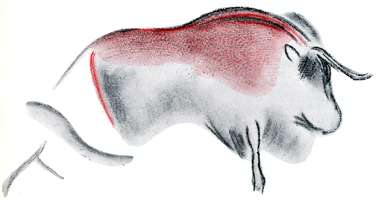
Red and black Bison
At 200 cm above the ground is a bison 130 cm long, in a polychrome painting of brown-black and red.
The bison has black head, ears, beard and horns, the front leg and the remainder of the stomach and leg, as well as a line of the tail, and an outline in black over the hump.
In red, a straight line borders the rump, and over the kidney region, while a third red line is sandwiched between two black lines of the dorsal hump, and the whole area from the tail to the neck is painted brown. Today, the painting has faded so badly that the polychrome shadings have almost disappeared, leaving only black colorations.
Photo and translated text: after Breuil et al. (1925), in Beltrán et al. (1967)
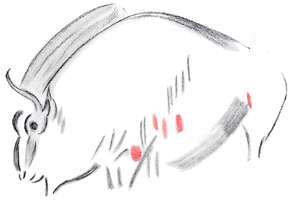
Large bison in black, with some red modelling.
Turned to the left is a large black bison, modelling incomplete, 240 cm long; only the forequarters and half of the body are well preserved. His side is marked with four red vertical bars. On top of his kidneys I noticed a rocky protuberance, a natural relief accented by a small stroke.
Photo and translated text: after Breuil et al. (1925), in Beltrán et al. (1967)
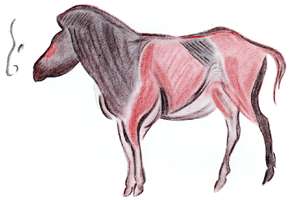
Polychrome Horse
A figure of great scientific importance that must have been very beautiful when first painted. This is the best painting at Bédeilhac.
It is the image of a large multi-colored horse on the right hand wall, measuring 240 cm long by 120 cm from the hind hoof to the root of the tail. This horse was painted 130 cm above the ground at the level of the hooves and was very clear at the time of my sketches.
Photo and translated text: after Breuil et al. (1925), in Beltrán et al. (1967)
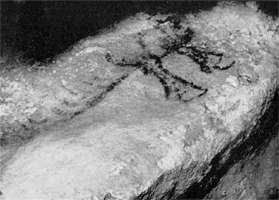
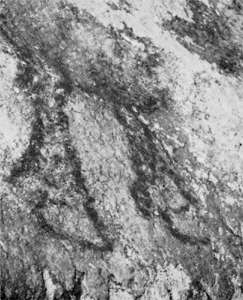
Head and lower abdomen of a Bison.
The bison was discovered by R. Gailli and A. Beltran on September 26, 1966 at the end of the left branch of the "Bison side passage" in a narrow crack of just 40 cm width. It is unreachable except through a small gap of 38 by 36 cm, which had to be made larger in order to get through. The painting is on the left wall, with its head towards the end of the passage, and is about 2 metres from the entrance hole.
Painted in black, the drawing is clear and vigorous. It measures 94 cm nose to tail, with a maximum height of 60 cm, and 58 cm in length along the belly.
The only parts of the figure to be seen are the head, front legs and belly line, without the hindquarters and the line of the back, which is replaced by a natural contour of the rock.
The legs are of excellent workmanship, and are seen in profile, with the right leg 37 cm in length, and its hoof 8 cm. For the left leg, the dimensions are 24 cm and 6 cm respectively. The right leg starts, with great naturalness, above the line of the belly, while the left is drawn so that it appears from behind the belly.
The belly shows a marked softness and delicacy, and the effect is enhanced with short slightly curved parallel lines that make an acute angle with the outline of the body.
The lower part of the head is visible, and shows pale colouring and stripes of paint to indicate the animal's thick coat.
The similarities with the bisons of the "Salon Noir" of Niaux are obvious, and the comparison of this image with them can help to complete the missing parts of this important figure.
Photo and translated text: after Robert (1946), in Beltrán et al. (1967)
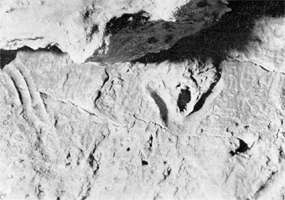
Vulva
A female sexual representation, realistic, deeply drawn by the fingers. The grooves are 25 mm in depth, the maximum width is 120 mm, and the object is 90 mm in height.
The appearance is of a triangle with the bottom up, and clay between the two sides is slightly squashed by the fingers. On the figure are finger marks, apparently intended to represent the start of the pubis. To the left of the vulva can be seen the traces of three fingers together dragged in the clay.
Photo and translated text: after Robert (1946), in Beltrán et al. (1967)
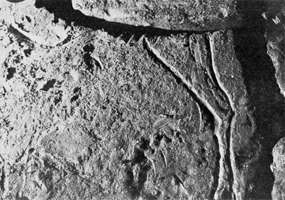
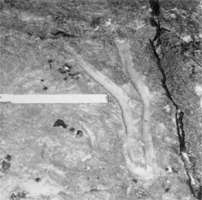
Deer leg recorded in clay in the Salle Terminale.
This engraving was discovered by Louis Bégouen in 1931 and was formed by a line drawn deep and wide. It is undoubtedly the hind leg of a deer of which currently very little remains, since someone has drawn a finger over the entire drawing, destroying its original appearance. Some can make out the beginning of the line of the belly, indicating that the animal could originally have been complete, but the rest has disappeared in a collapse.
(There appears to be a rock over the place where the rest of the engraving would have been - Don)
The leg measures 29 cm in length, and what could be the line of the belly is about 95 cm long.
Photo and translated text: after Robert (1946), in Beltrán et al. (1967)
References
- Bandi, H., 1988: Mise bas et non défécation. Nouvelle interprétation de trois propulseurs magdaléniens sur des bases zoologiques, éthologiques et symboliques, Espacio, Tiempo y Forma, Série I, Prehistoria, t. I, 1988, pp. 133-147
- Beltrán, A., Robert, R., Gailli R., 1967: La Cueva de Bédeilhac, Zaragoza 1967
- Breuil, H., Vidal G., 1925: Découverte de peintures à Bédeilhac. C.R. Acadédemie Inscriptions et Belles-Lettres. Séance du 14 août 1925, p.222
- Gailli, R., 2006: La Grotte de Bédeilhac - Préhistoire, Histoire et Histoires, Editions Larrey cdl, 2006
- Nougier, L., Robert, R., 1951, Hameçons néolithiques, Bulletin de la Société préhistorique française, 1951, tome 48, No. 7-8. pp. 307-322
- Robert, R., 1943: Nouvelles fouilles à Bédeilhac, Bulletin de la Société préhistorique française, 1943, tome 40, No.10-12, pp. 276-281
- Robert, R., 1946: Fouilles à la grotte de Bédeilhac, Bulletin de la Société préhistorique française, 1946, tome 43, No. 9-12. pp. 322-326
